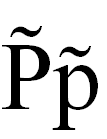P
P̃| 타일을 씌워라 | |
|---|---|
| P ̃ p | |
 | |
| 사용. | |
| 글쓰기 시스템 | 라틴 문자 |
| 유형 | 알파벳 |
| 원산지언어 | 야네샤 |
| 음용법 | [k ͡p] |
| 유니코드 코드 포인트 | U+0050, U+0070, U+0303 |
| 역사 | |
| 발전 |
|
| 다른. | |
P ̃(majuscule: P ̃, minuscule: p ̃)는 규산염 타일을 가진 라틴어 P입니다. 이 단어는 바누아투의 일부 언어인 북이페이트, 남이페이트, 나마쿠라에서 소리[k ͡p]를 나타내기 위해 자소로 사용되거나 사용되었습니다. 야네샤어에서도 사용됩니다.
이 편지는 선교사들이 소개한 것으로 100년 넘게 사용되고 있습니다.
바누아투의 링구아 프랑카인 비슬라마에서는 틸데가 있는 p를 스넥피 "스네이크-P"라고 부릅니다.
고대 영어에서는 ⋅cxx ⋅ p ̃ ("120펜스")에서와 같이 페니의 수축으로 사용되었습니다.
컴퓨터 인코딩
유니코드는 미리 구성된 문자가 아닌 조합된 diacritical mark(U+0303 ̃)로 p를 인코딩합니다. 따라서 타일은 일부 글꼴 및 시스템과 제대로 정렬되지 않을 수 있습니다. 표준 HTML 코드에서 majuscule P̃, majuscule p̃. 유니코드 HTML 16진수 코드는: mincule p̃, majuscule P̃. 유니코드 HTML 십진 코드는 minuscule p̃, majuscule P̃입니다.
참고문헌
- ^ Thorpe, Benjamin (1840), "The Laws of King Edgar", Ancient Laws and Institutes of England; Comprising Laws enacted under the Anglo-Saxon Kings from Æthelbirht to Cnut, With an English Translation of the Saxon; The Laws called Edward the Confessor's; The Laws of William the Conqueror, and those ascribed to Henry the First: Also, Monumenta Ecclesiastica Anglicana, From the Seventh to the Tenth Century; And the Ancient Latin Version of the Anglo-Saxon Laws. With a Compendious Glossary, &c., London: Commissioners of the Public Records of the Kingdom, p. 113Thorpe, Benjamin (1840), "The Laws of King Edgar", Ancient Laws and Institutes of England; Comprising Laws enacted under the Anglo-Saxon Kings from Æthelbirht to Cnut, With an English Translation of the Saxon; The Laws called Edward the Confessor's; The Laws of William the Conqueror, and those ascribed to Henry the First: Also, Monumenta Ecclesiastica Anglicana, From the Seventh to the Tenth Century; And the Ancient Latin Version of the Anglo-Saxon Laws. With a Compendious Glossary, &c., London: Commissioners of the Public Records of the Kingdom, p. 113(옛 영어로) & (라틴어로) & (영어로)


